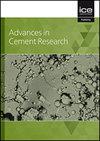含微胶囊化相变材料的硫铝酸钙生态水泥涂料的制备
IF 1.3
4区 工程技术
Q3 CONSTRUCTION & BUILDING TECHNOLOGY
引用次数: 0
摘要
一方面,硫铝酸钙(CSA)生态水泥在制造过程中释放的二氧化碳(CO 2)比波特兰水泥少约40%;另一方面,分散在胶凝基质中的相变材料可以帮助优化建筑物的室内温度,减少与供暖/空调相关的二氧化碳排放。然而,这只有在作为薄层(涂层)使用时才具有经济可行性。此外,两种材料的结合具有双重的环境效益。因此,本工作的主要目的是制备一种合适的均匀且粘附良好的双层样品,由CSA和CSA- mpcm组成。为了实现这一目标,在第一步,研究了pH、温度和搅拌对微胶囊化相变材料(MPCM)水溶液悬浮液(47.3% wt%)的影响;其次,将MPCM(相对于干水泥的45%)分散在CSA膏体中;然后,在第三步中,在CSA基体上获得均匀且粘附良好的CSA-MPCM涂层,其中MPCM未损坏。这是通过流变学测量和显微镜检查实现的。最后,对相应的CSA和CSA- mpcm砂浆的力学性能(压缩)(7 d时分别为70和13 MPa)和导热系数(分别为2.06和1.19 W/mK)进行表征。本文章由计算机程序翻译,如有差异,请以英文原文为准。
Processing of calcium sulfoaluminate eco-cement coatings containing microencapsulated phase change materials
On the one hand, calcium sulfoaluminate (CSA) eco-cements release about 40% less carbon dioxide (CO 2 ) than Portland cement during fabrication; on the other hand, phase change materials dispersed in a cementitious matrix can help to optimise the indoor temperature of buildings, reducing carbon dioxide emissions related to heating/air conditioning. However, this is only economically viable if it is used as a thin layer (a coating). In addition, the combination of both materials supposes a double environmental benefit. Consequently, the main objective of this work is the preparation of a suitable homogeneous and well-adhered bilayer sample, composed of CSA and CSA-MPCM. To achieve this, in the first step, the effect of pH, temperature and stirring was studied for microencapsulated phase change material (MPCM) aqueous suspensions (47.3 wt%); second, the MPCM (45 wt% with respect to dry cement) was dispersed in a CSA paste; then, in a third step, a homogeneous well-adhered coating of CSA-MPCM, with undamaged MPCM, was obtained on a CSA matrix. This was achieved through rheological measurements and checked by microscopy. Finally, the corresponding CSA and CSA-MPCM mortars were characterised through their mechanical properties (compression) (70 and 13 MPa at 7 days, respectively) and thermal conductivity (2.06 and 1.19 W/mK, respectively).
求助全文
通过发布文献求助,成功后即可免费获取论文全文。
去求助
来源期刊

Advances in Cement Research
工程技术-材料科学:综合
CiteScore
3.70
自引率
5.00%
发文量
56
审稿时长
3.2 months
期刊介绍:
Advances in Cement Research highlights the scientific ideas and innovations within the cutting-edge cement manufacture industry. It is a global journal with a scope encompassing cement manufacture and materials, properties and durability of cementitious materials and systems, hydration, interaction of cement with other materials, analysis and testing, special cements and applications.
 求助内容:
求助内容: 应助结果提醒方式:
应助结果提醒方式:


